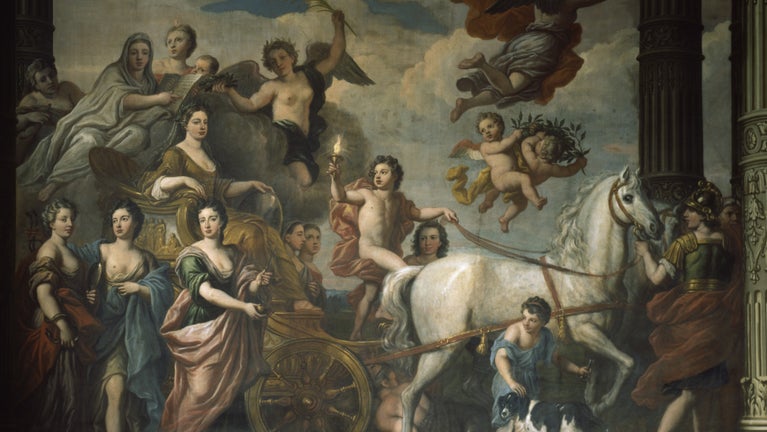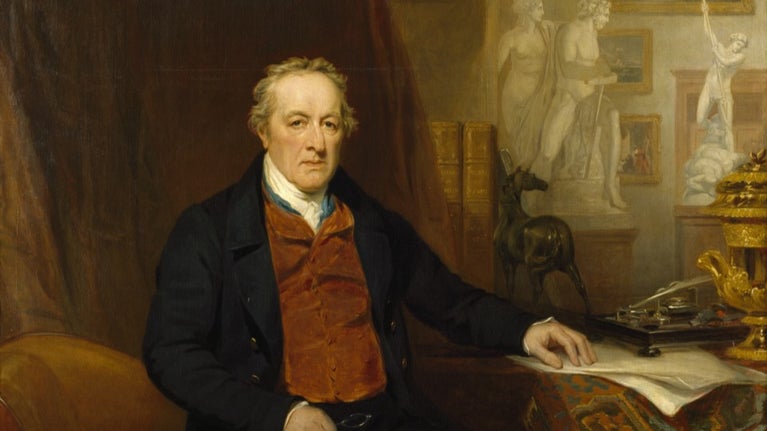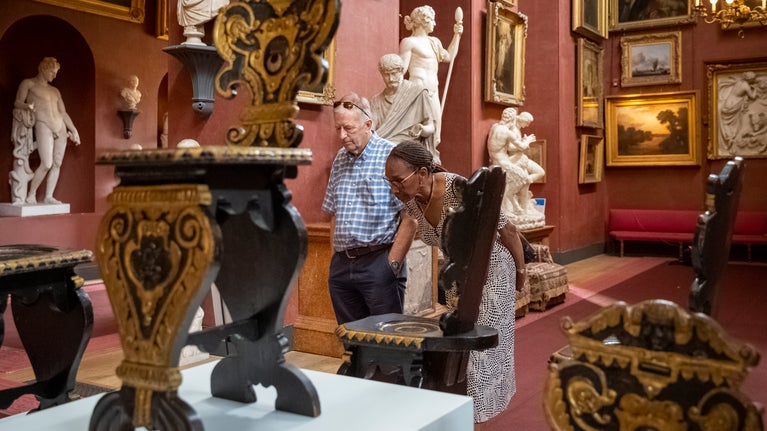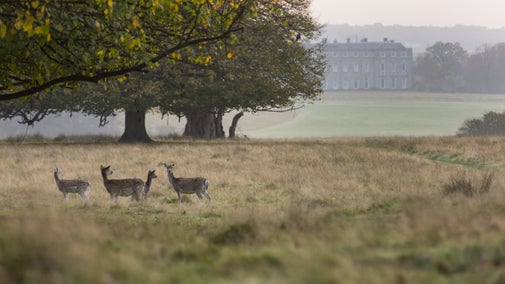
Discover more at Petworth
Find out when Petworth House and Park is open, how to get here, the things to see and do and more.

The history of Petworth House and Park stretches back almost 900 years. Once a medieval manor house, it was transformed in the 17th century to the grand, baroque palace you see today. In the next century, Lancelot ‘Capability’ Brown designed a new park and garden landscape. Petworth House is home to one of the most significant collections of art in the United Kingdom, amassed over the centuries by the Percy, Seymour and Wyndham families.
The name Petworth is from the Old English ‘Pytta’s wyrth’ or ‘Pytta’s plot’. The town was recorded in Domesday Book of 1086 as Peteorde, with a population of 44 households.
In 1150, Queen Adeliza de Louvain (c. 1103–51), the widow of King Henry I, gave the land as a royal gift to her half-brother, Joceline de Louvain (died c. 1180). Joceline married Agnes de Percy (d.1204) who inherited the family estates including Petworth. Evidence of early history can still be seen today in the chapel, which survives from the medieval great house which was fortified in 1308–9.

The Percy family were major landowners. In addition to Petworth, they held estates in Yorkshire, Northumberland, Cumbria, South Wales, Somerset and Dorset. During the Wars of the Roses (1455–87), the family supported the Lancastrians, and the successful Yorkist King Edward IV confiscated their estates. In 1470, Henry Percy, 4th Earl of Northumberland (c. 1449–89), regained them from the Crown.
Henry Percy, 6th Earl of Northumberland (c. 1502–37), was in a relationship with Anne Boleyn before she married King Henry VIII. In 1536, the 6th Earl was a member of the jury who condemned Anne to death for high treason. Henry VIII visited Petworth in 1526 when he is recorded as having a ‘good game and recreation’.
In 1537, the royal family inherited the Percy estates from the 6th Earl of Northumberland, but 21 years later they were given back to Thomas Percy, 7th Earl of Northumberland (c. 1528–72). Both Thomas and his bother Henry Percy, 8th Earl of Northumberland (c. 1532–85), were imprisoned in the Tower of London at different times for their support of Queen Elizabeth I’s rival, Mary Queen of Scots.
Henry Percy (1564–1632), 9th Earl of Northumberland was nicknamed the ‘Wizard Earl’ for his interest in science and alchemy. He inherited all the Percy estates in 1585 after his father, the 8th Earl, was found shot dead in the Tower of London.
He inherited his father’s servants and recruited new ones, whom he described in his manuscript ‘Advices to his Son’ (1609) as ‘young, handsome, brave swaggering, debauched, wild’. In 1586 he had 58 members in his household. One was a person of African origin, probably enslaved or in indentured service, for whom the Earl is recorded as having paid 20 shillings.
In 1605, the 9th Earl was imprisoned in the Tower of London for his alleged association with the Gunpowder Plot against King James I. He spent almost 17 years in the Tower. His fellow prisoner Sir Walter Raleigh, the English explorer and colonial investor, is said to have gifted him the earliest surviving English terrestrial globe, still in the collection today.
Algernon Percy, 10th Earl of Northumberland (1602–68), was a member of the ‘Whitehall group’. This group of connoisseurs, collectors and advisors formed around King Charles I, and are credited with introducing the taste for European paintings to England. The 10th Earl collected important paintings by artists such as Titian, Adam Elsheimer and Sir Peter Lely. He was also a friend and notable patron of the Flemish artist Anthony van Dyck, who became court painter in 1632.
The 10th Earl held a variety of political roles including Admiral of the Fleet (1636–8), Lord High Admiral (1638–42) and Commander of the Army in the 2nd Scottish War (1639–40). He also conducted Parliament’s negotiations with the King during the British Civil War (1642–51). His two marriages to Anne Cecil (1612–37) and Elizabeth Howard (c.1622–1705) produced three children including Josceline Percy, 11th Earl of Northumberland (1644–70).
When the 11th Earl died his daughter, a three-year-old Lady Elizabeth Percy (1667–1722), inherited the family estate but not the title. Her third and final marriage was in 1682 to Charles Seymour, 6th Duke of Somerset (1662–1748). Her family money, combined with his title and their active roles at the royal courts, made them an influential couple. They substantially transformed Petworth into the baroque palace we see today.
Together, they commissioned some of the finest surviving late 17th to early 18th-century art and interiors by artists such as Michael Dahl, Louis Laguerre and Grinling Gibbons. Their only surviving son was Algernon Seymour, 7th Duke of Somerset (1684–1750).

Charles Wyndham, 2nd Earl of Egremont (1710–63), inherited Petworth from his uncle, the 7th Duke who had no male heir. The 2nd Earl was the Secretary of State for the Southern Department (1761–63). This role held a variety of responsibilities for domestic and Irish policy, colonial policy and foreign affairs, including hosting a North American Cherokee delegation visit to London in 1762.
During this time, he employed Lancelot ‘Capability’ Brown to create the park landscape, one of the best surviving examples of his work. The 2nd Earl was also an avid collector of ancient Greek and Roman sculpture, much of which remains in its original location in the house.
George O’Brien Wyndham, 3rd Earl of Egremont (1751–1837), was a great patron of the arts, agriculturalist, business investor, and one of the most successful racehorse owners in history. The 3rd Earl’s annual income was about £100,000 (£4.5M today) a year, mainly from the ownership of 11,000 acres of land across England and Ireland. He took on the name O’Brien on inheriting his uncle Percy Wyndham-O’Brien’s Irish estates.
The 3rd Earl was involved in British politics; he supported parliamentary candidates campaigning for the abolition of the trade of enslaved people and opposed the Poor Law Amendment Act (1834) which introduced a harsh workhouse system. He spent about £20,000 a year on local causes, including the Petworth Emigration Committee. Between 1832–37, this scheme to aid rural poverty relocated about 1,800 people of the working-class to Canada, settling them on land acquired through colonial rule.
The Countess of Egremont, Elizabeth Ilive (1769–1822), had eight children with the 3rd Earl – George, Frances, Henry, Edward, Charles, William, Charlotte and Elizabeth. The Countess was an amateur scientist, setting up a private laboratory at Petworth and inventing a crossbar lever for lifting stones. She also ‘took great delight in painting’ and commissioned works by the artist William Blake.
The 3rd Earl was a major patron of art and supported a generation of British artists, acquiring works by J.M.W. Turner, John Flaxman and Angelica Kauffman. His creation of the North Gallery is a rare example of a top-lit, country house art gallery with a collection that rivals those of international museums.
Petworth became an unofficial academy of art, referred to as 'that House of Art' by John Constable in 1834. Turner was a frequent visitor to Petworth, painting a series of views of the house interiors and surrounding parkland, some of which can still be seen in the collection.

In 1869, the fashionable architect Anthony Salvin was employed by Henry Wyndham, 2nd Lord Leconfield (1830–1901), and his wife Constance Primrose (1846–1939) to make changes to parts of the house and grounds. They commissioned interior furnishings from Morris & Co. including bespoke velvet curtains, some of which remain in the house.
In 1920, Charles Wyndham, 3rd Lord Leconfield (1872–1952), commissioned a full ‘Catalogue of the Petworth Collection of Pictures’ from the art historian Charles Henry Collins Baker. In 1927 the 3rd Lord Leconfield sold paintings by significant artists (including Rembrandt), some of which are now in museums in the United States of America.
During the Second World War (1939–45) the house became a hospital and nursery, and the British and Canadian military used the park for accommodation and training. A camp remained as housing for displaced Polish personnel who continued to live on the site until the 1960s.
In 1947 the 3rd Lord Leconfield gave Petworth House and Park to the National Trust with an endowment of £300,000. After his death, in 1956–7 his nephew and heir, John Wyndham, 6th Lord Leconfield and 1st Lord Egremont (1920–72), arranged for the acceptance of art collections in lieu of death duties, the first ever arrangement of its type.
The Wyndham family continue to live in the house and own the wider Leconfield Estate surrounding the National Trust property. Existing staff continued to work at Petworth House, including Head Gardener Fred Streeter (1879–1975), who co-presented BBC programmes such as ‘Home Grown’ and ‘Television Garden’ in the 1940s–70s.
Over the last 75 years, the National Trust has continued to develop Petworth House and Park as a major visitor attraction and home to one of its finest art collections. It has undertaken major redisplays, building and collections conservation, exhibitions, and landscape work.


Find out when Petworth House and Park is open, how to get here, the things to see and do and more.
Make a day of your visit to Petworth House and Park by visiting the historic market town too. Find out how the town and estate are linked.

From famous pieces of art and sculpture to decorative arts and furniture, explore some of the most important collections in the National Trust.

From the medieval interiors of the chapel to the rooms of the historic kitchens, find out what you can see on a visit to the house at Petworth.

The ‘Capability’ Brown designed parkland at Petworth House has much to explore. Discover things to do and what to keep an eye out for when you visit.

Discover the relationship painter JMW Turner had with Petworth House and Park and explore its legacy.

Petworth House and Park in West Sussex has been home to just one family for over 900 years. Discover their fascinating stories, from tales of execution to royal favour and epic house renovations.
